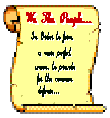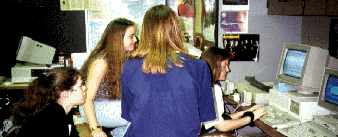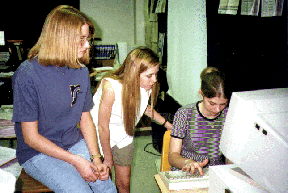
The objective in writing for the Internet is to have a wide-reaching audience review and critique the writing of the students by e-mail so that they will perform better on the AP US History exam and in historical writing in general.
 |
Students discussing a historical question in a group. |
 |
Students researching a topic in a |
 |
Mr. Cassutto assists in developing the rough draft. |
 |
Carly concentrates on her essay as she
composes |
 |
Students refine their essays. |
Rough drafts are placed on floppy disks and printed out by the instructor. The instructor reviews and provides criticism for the students. They are then given the opportunity to correct and improve their essays based on the instructor's comments. Students are given a grade for both the rough draft and final draft, but the grade must be given before the students receive feedback from internet-based readers.
 |
Students put the finishing touches on their essays |
The instructor uploads the final versions to the school's website and places announcements on internet mailing lists and newsgroups dealing with education, US History or Social Studies. Scholars from all over the world are invited to read and critique the essays. The following criteria for evaluation of the essays are placed in the announcements:
1. Is there a thesis and does it apply to the question?
2. Are historical documents used in a substantial way to prove the position taken in the thesis?
3. Is outside information present and does it support the position taken in the thesis?
4. Does the conclusion do a good job of wrapping up the essay and restating the position of the thesis.
 |
Doug and Jason read incoming reviews of their essays. |
Students are informed of reviews as they come in. Reviews may arrive the next day or even years after the essay has been posted, but the instructor passes the review on only if it is constructive and is designed to help the student. Flames and provocative reviews are withheld by the educator. Students are given the opportunity to respond to their critics my e-mail (after preview by the teacher), and students are encouraged to thank reviewers for their time and effort. Moreover, students discuss their reviews in class and in their groups. They also maintain portfolios that contain all the evaluations they have received in order to track their progress.
| Our exam HH0-120 exam product, exam RedHat Certification dumps and 70-648 exam certification material are prepared and updated on regular basis by our experts. You can use Microsoft certifications dumps and 000-977 lab prepration to pass the exam with excellent marks. |
| Learning history is an important part of any education. Without examining our history we're bound to repeat our mistakes. Some of the more popular history topics include ancient history, medieval history and US history. The history of the US isn't as thorough as some of the European countries since the United States has only been around for 231 years. If world history doesn't interest you, you should try researching your region's history which might be more exciting since you actually live there. |